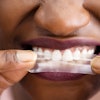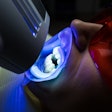Using remineralizing agents following in-office teeth whitening with 35% to 38% hydrogen peroxide does not help tooth enamel fully recover its microhardness over time, according to a new study in Acta Odontologica Scandinavica (March 2013, Vol. 71:2, pp. 343-348).
Previous studies have shown that bleaching with high amounts of hydrogen peroxide can alter enamel morphology and mineral content, according to the study authors, from the University of Pernambuco and Potiguar University schools of dentistry.
To test this theory and the role remineralizing agents might play in maintaining the morphology and microhardness of enamel, the researchers bleached 60 bovine incisors using either a calcium-containing 35% hydrogen peroxide or a calcium-free 35% hydrogen peroxide (n = 30). The teeth (n = 10) were then subjected to one of three remineralizing treatments: storage in artificial saliva only, application of a sodium fluoride gel or application of a nanohydroxyapatite-based agent.
The enamel morphology and microhardness were re-evaluated after 24 hours and 14 days of postbleaching treatments. The researchers found that teeth exposed to the nanohydroxyapatite-based agent presented statistically the highest microhardness 24 hours after its application. However, the microhardness recovery did not occur in any of the groups 14 days after treatment. In addition, the morphology of all samples 14 days after the application of all remineralizing agents presented a higher number of irregularities, the researchers reported.
"Although some remineralizing products provided microhardness recovery and a positive effect on enamel morphology at 24 [hours] postbleaching, none of them were able to maintain microhardness and enamel morphology at 14 days postbleaching," they concluded.



















